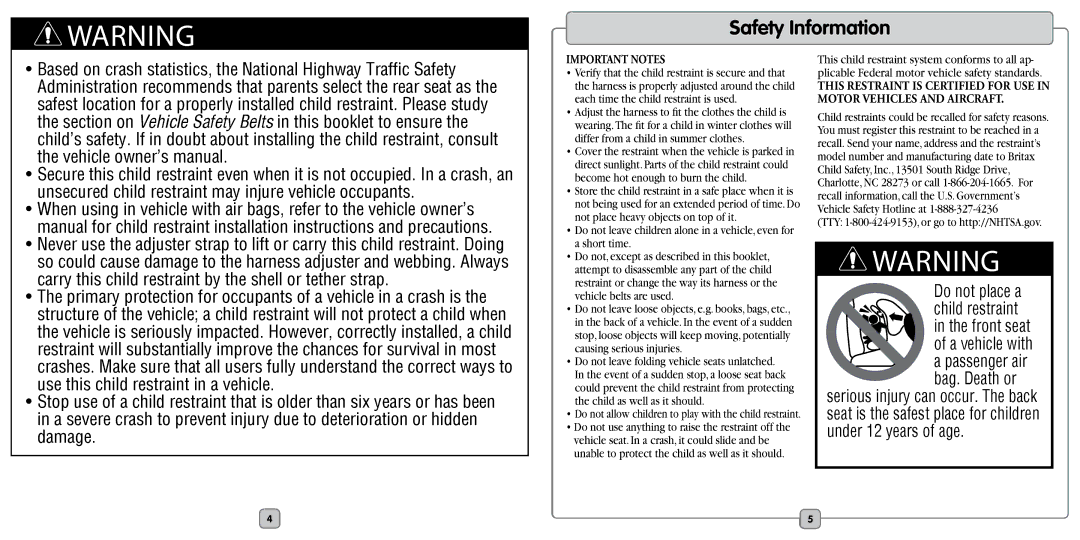
![]() warning
warning
SafetyFeatuInformationes
•Based on crash statistics, the National Highway Traffic Safety
Administration recommends that parents select the rear seat as the safest location for a properly installed child restraint. Please study the section on Vehicle Safety Belts in this booklet to ensure the child’s safety. If in doubt about installing the child restraint, consult the vehicle owner’s manual.
•Secure this child restraint even when it is not occupied. In a crash, an unsecured child restraint may injure vehicle occupants.
•When using in vehicle with air bags, refer to the vehicle owner’s manual for child restraint installation instructions and precautions.
•Never use the adjuster strap to lift or carry this child restraint. Doing so could cause damage to the harness adjuster and webbing. Always carry this child restraint by the shell or tether strap.
•The primary protection for occupants of a vehicle in a crash is the structure of the vehicle; a child restraint will not protect a child when the vehicle is seriously impacted. However, correctly installed, a child restraint will substantially improve the chances for survival in most crashes. Make sure that all users fully understand the correct ways to use this child restraint in a vehicle.
•Stop use of a child restraint that is older than six years or has been in a severe crash to prevent injury due to deterioration or hidden damage.
TypeIMPORTANT NOTES
•Verify that the child restraint is secure and that the harness is properly adjusted around the child each time the child restraint is used.
•Adjust the harness to fit the clothes the child is wearing.The fit for a child in winter clothes will differ from a child in summer clothes.
•Cover the restraint when the vehicle is parked in direct sunlight. Parts of the child restraint could become hot enough to burn the child.
•Store the child restraint in a safe place when it is not being used for an extended period of time. Do not place heavy objects on top of it.
•Do not leave children alone in a vehicle, even for a short time.
•Do not, except as described in this booklet, attempt to disassemble any part of the child restraint or change the way its harness or the vehicle belts are used.
•Do not leave loose objects, e.g. books, bags, etc., in the back of a vehicle. In the event of a sudden stop, loose objects will keep moving, potentially causing serious injuries.
•Do not leave folding vehicle seats unlatched. In the event of a sudden stop, a loose seat back could prevent the child restraint from protecting the child as well as it should.
•Do not allow children to play with the child restraint.
•Do not use anything to raise the restraint off the vehicle seat. In a crash, it could slide and be . unable to protect the child as well as it should.
This child restraint system conforms to all ap- plicable Federal motor vehicle safety standards.
This restraint is certified for use in motor vehicles and aircraft.
Child restraints could be recalled for safety reasons. You must register this restraint to be reached in a recall. Send your name, address and the restraint’s model number and manufacturing date to Britax Child Safety,1Inc., 13501 South Ridge Drive, . Charlotte, NC 28273 or call
(TTY:
![]() warning
warning
Do not place a child restraint in the front seat of a vehicle with
a passenger air bag. Death or
serious injury can occur. The back seat is the safest place for children under 12 years of age.
4 | 25 |
